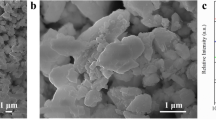Abstract
Ceramic matrix composites have to overcome two major barriers for applications in aircraft and stationary turbines/engines. One is the unacceptably high processing cost to obtain sufficient mechanical properties and the other is their poor corrosion resistance under hydrothermal oxidizing conditions typical of engines and turbines. Functional geopolymer composites provide possible solutions to the above two problems since they can be formed by technologically simple processing routes and the hydrothermal corrosion resistance can be improved by tailoring material compositions. In this paper geopolymer matrix materials with superior hydrothermal corrosion resistance were processed from the selected geomimetic compositions. The effects of processing parameters, such as particle size, extent of dissolution, and firing temperature on the compressive strength and microstructures were examined and specimens with a compression strength as high as ∼99 MPa were fabricated. Hydrothermal test experiments on KOH-derived geopolymer specimens showed that all of potassium-bonded geopolymer specimens have minimal mass change or dimensional change during hydrothermal exposure in spite of the phase change.











Similar content being viewed by others
References
Ohnabe H, Masaki S, Onuzuka M, Miyahara K, Sasa T (1999) Compos A Appl Sci Manuf 30:489
Claussen N (1999) Br Ceram Trans 98:256
Spitsberg I, Steibel J (2004) Int J Appl Ceram Technol 1:291
Colomban P (1997) Mat Sci Forum 251–254:833
Davidovits J, Davidovics M (1991) In: 36th International SAMPE symposium, San Diego, p 1939
Davidovits J (1991) J Thermal Anal 37:1633
Steveson M, Sagoe-Crentsil K (2005) J Mater Sci 40:2023
Xu H, van Deventer JSJ, Lukey GC (2001) Ind Eng Chem Res 40:3749
Rahier H, Denayer JF, Van Mele B (2003) J Mater Sci 38:3131
Barbosa VFF, MacKenzie KJD, Thaumaturgo C (2000) Int J Inorg Mater 2:309
van Jaarsveld JGS, van Deventer JSJ, Lukey GC (2002) Chem Eng J 89:63
Bjorn Mysen O (1990) Phase diagrams for ceramists, 8, Fig. 07985-C, p 108
Acknowledgement
This material is based upon work supported by the AFOSR under Contract No. FA9550-04-C-0038 (Previously F49620-02-C-0075).
Author information
Authors and Affiliations
Corresponding author
Rights and permissions
About this article
Cite this article
Nair, B.G., Zhao, Q. & Cooper, R.F. Geopolymer matrices with improved hydrothermal corrosion resistance for high-temperature applications. J Mater Sci 42, 3083–3091 (2007). https://doi.org/10.1007/s10853-006-0526-5
Received:
Accepted:
Published:
Issue Date:
DOI: https://doi.org/10.1007/s10853-006-0526-5




